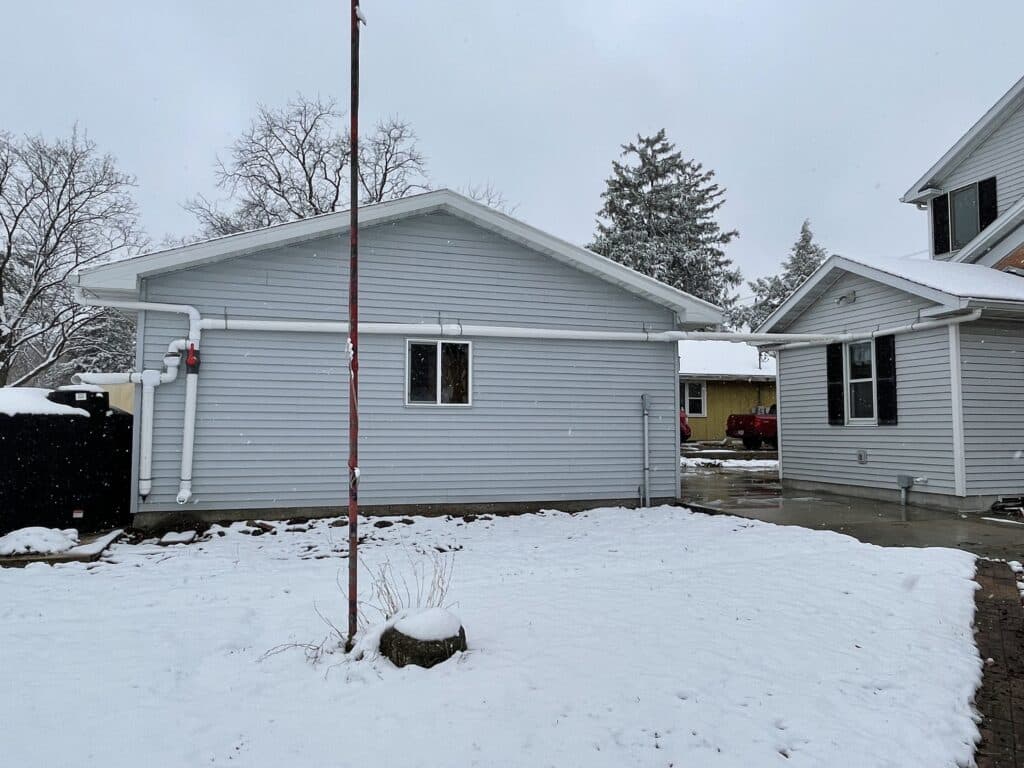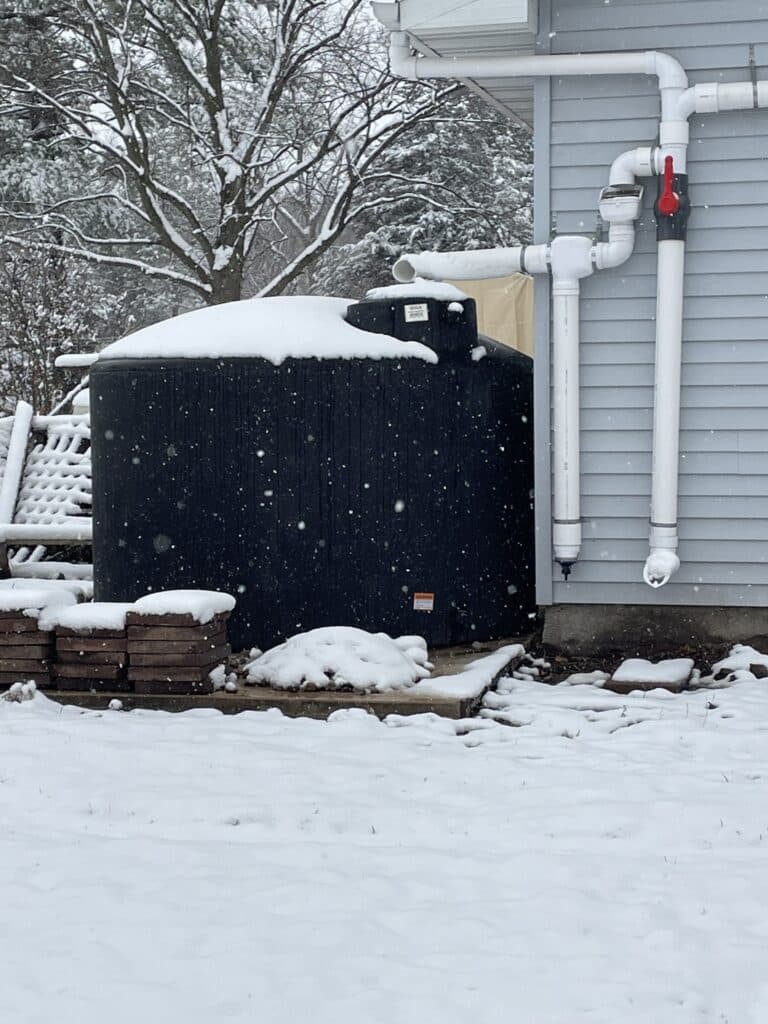
Scott Horton's Water Feature
From Scott:
The 3200 gallon water feature (3 descending pools of water each fed by a cascade) that can be viewed from the “Command Center” (a living area on the upper floor of our home in Omro, Wisconsin where my sweetheart, Debbie, envisioned the family being able to work on computers, teach homeschool, and just chill with our cats) is… well, beautiful. But the warmest of summer temperatures (yes, believe it or not, it is not subzero during the summer in Wisconsin) can have quite the evaporative effect on our beautiful outdoor “aquarium” that teams with very expensive fish (some were 17 cent goldfish; some were 34 cent goldfish). A pump circulates the water from the “lower pool” to the cascade flowing into the “upper pool” to stir and aerate the water. A certain level of water needs to be maintained in the lower pool to ensure circulation and to keep the pump from burning out. (Of course, the beautiful mostly orange fish enjoy the relatively full watery living quarters in the main, “middle pool” oblivious to the hydrodynamic balance that must be maintained.)
For the first four summers that we have lived in Omro, we refilled the lower pool with some consistency to maintain the desired water level from city-supplied water. Even though this was “outdoor water” on a separate, cheaper water meter, I felt that I was spending money I would like to target for other items (can you really ever have enough popcorn on hand?!).
Once the raised-bed garden (see recent journal entry) was conceived and constructed, the idea of harvesting water off the roof of my detached garage started to form and subsequently crystalized. I had the desire to only use rain water to fill the water feature and to water the newly built garden when rain provided from those clouds above was not sufficient.

Note: The pictures in included (accented by snow) were actually taken in the 2nd week of October).

The most important item in all of this planning was the size and shape of the water storage tank that would determine the capacity and allowable height of what would be the heart of this system. Based on on-line research and careful measurements (yes, made not once or twice, but several times), a 1550 gallon tank that was 67 inches high was settled on– big enough to store a lot of water, but short enough to have water from both sides of the garage roof have the proper pitch to run in pipes to fill the tank.
An additional “hope” was to also gather water from about ⅓ of the house roof as well (which would have to span about a 10 foot gap to enter into the pipe that gathers the water from the north side of the garage). An added bonus, if successful, was to remove the two downspouts that dump water from this portion of the house’s roof onto the sidewalk and into our backyard (though the water being dumped there was not really a problem due to the gradual slope away from the house). However, in the winter for days that are warm enough for the snow to melt from the roof, the water dripping off the roof will freeze on the sidewalk causing a continual hazard for a large portion of the winter. Since the house is just a little higher than the garage and allows that 10 foot gap to be bridged and gravity to work its magic in having a significant portion of rain water from the house also contribute to the storage (and avoid a little “ice rink” from being formed to boot!).
Parts of Saturdays and some evenings were spent cutting, connecting, cementing pipes together (OK, this engineering marvel cannot compete with Roman or Near Eastern water systems, but I was happy with the plan and the resulting, if you will, “above-ground” cistern–can I really say that?).
Once all was done, and the tank in position, the first rain storm (and we get some real doosies in the Midwest) decided to help test the “works”; I was so anxious I had to go outside in the steady (but not heavy) rain and get some up close and personal data. I guess I should not have been so surprised, but the volume of water emptying from the pipe into the tank was significant when compared to the small drops falling on any particular square foot of roof–a testament to the effect of concentrating a little bit of water falling on a large area. A few weeks later, during a heavy downpour (what I love to call a thunder-bumper), the pipe was gushing with water and, though the rain was heavy, in only about 40 minutes, the level of water in the tank jumped over 2 feet (due to the shape of the tank, I would estimate around 600 gallons was stored in that time).
Some other notes… The tank is black. This choice of color was made to keep light from penetrating and encouraging algae growth. A few feet before the water empties into the tank, the pipe ends and water (mostly 😉 ) passes through a slanted screen designed to keep leaves, twigs, and other debris from entering the tank. In addition, as Wisconsin winters are… …um, COLD, a valve was installed in the pipe to allow runoff to either go into that tank or into a downspout and disperse onto the backyard lawn. I did not want the tank to rupture during the winter when the water expands when being converted to its solid state; so I drained the tank in early November before temperatures drop too low.
Two more items helped finish the system. First, a downspout with a plastic float inside and only a tiny aperture in a rubber washer at the bottom. This allows the initial water coming off the roof to fill this downspout with very small debris that can pass through the original screen–to keep the water flowing into the tank as free as possible from even smaller debris. Once the downspout is filled the plastic float prevents almost all water from entering it and thus is directed to the tank (the aperture at the bottom is about the size of the diameter of a large sewing needle and allows the water to slowly drain after the rain stops).
And last, a screen covers the opening of the tank where the water enters; this is to keep critters or even mosquitoes from entering and fouling the water. I could have designed the pipe to extend inside the tank and not have a gap. I did not for two reasons: 1) to allow the tank to be moved if a need should arise and 2) to allow the overflow to exit from that same entrance. The tank is on a concrete pad that will keep erosion of the soil from occurring; that pad was part of the foundation of an old building we took down when replacing the old garage. I left the pad thinking we might use it for something… lawn chairs? Evenings around a fire? …but I had no idea it would end up being a perfect foundation for a water storage tank that I only thought about creating 3 years later.
You might wonder why I want the water stored to be this “nice” for goldfish and garden vegetables… …the idea of also having this filled tank as an emergency water supply of a significant size (in addition to the barrels inside our home) seemed to be prudent. You might think, “but you empty it in November and don’t starting fill it again until late March”; well, for a good portion of the months when it is empty, we do have a separate water storage “feature” on our property; it is the beautiful white stuff covering our lawn and that is piled up near our driveway. Note: after drafting this entry last night, 8” of heavy (i.e. water-laden) snow beautified our home (and “refilled” our extra 😉 outside water storage.